Steelhead Alley Fishing: Tactics And Tips From Guides
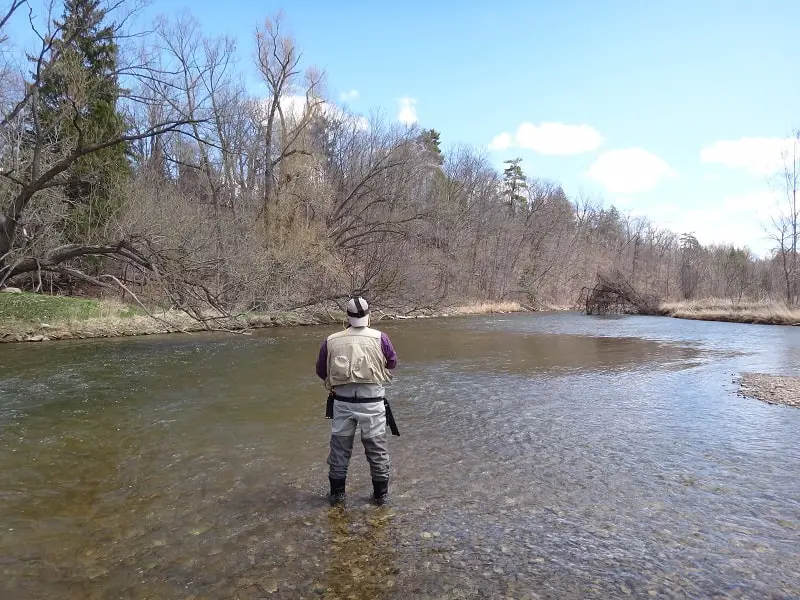
Steelhead Alley refers to the collection of steelhead tributaries on the southern shore of Lake Erie bordering Pennsylvania, New York, and Ohio. This region is known to contain some of the most productive steelhead streams in the Great Lakes region, and all are within close proximity to each other.
The great fishing in Steelhead Alley is thanks to good management and stocking efforts in the three home states.
Steelhead Alley Fishing
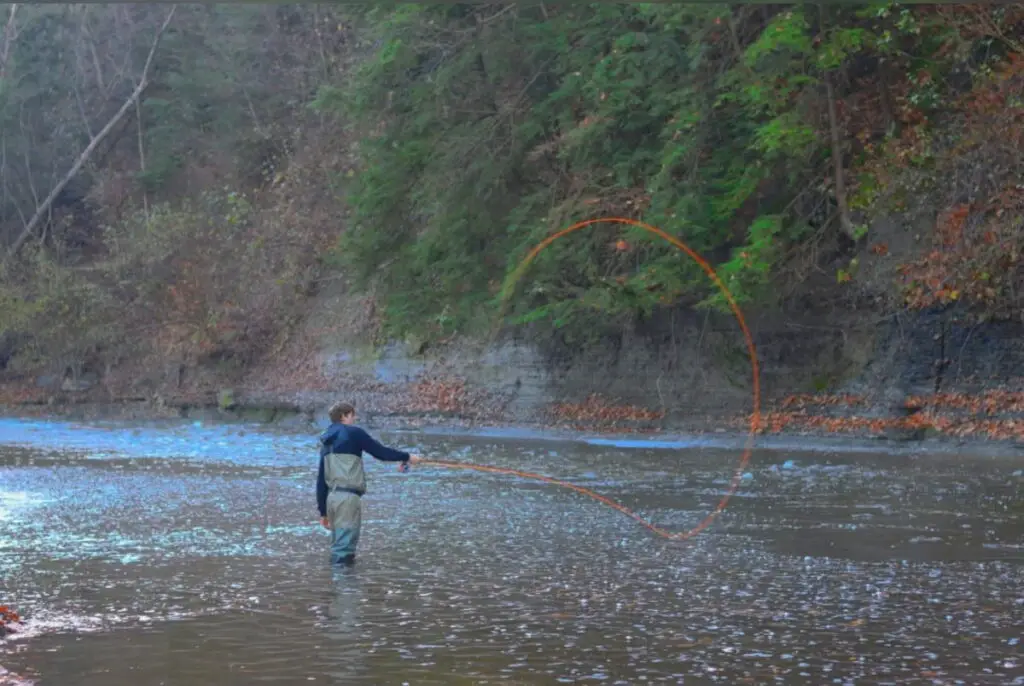
All the rivers and creeks in the Steelhead Alley combined are stocked with hundreds of thousands of steelhead annually for the purpose of promoting recreational fishing, and this makes this area fantastic for steelhead anglers.
After being stocked in these Steelhead Alley tributaries, the steelhead spend about two years of their juvenile years in their native freshwater streams for development and afterward make their way to Lake Erie to spend their adult lives.
This migration to Lake Erie allows steelhead to attain a much more rapid growth thanks to the much richer forage base in the Great Lakes, which is otherwise not available in the freshwater tributaries.
After maturity, the steelhead make their way back to their native streams and rivers where they were stocked or born for the purpose of spawning. This is usually when they are targeted by most steelhead anglers.
With all being said, let us take a look at the top rivers and creeks that make up the Steelhead Alley.
Steelhead Alley in Ohio
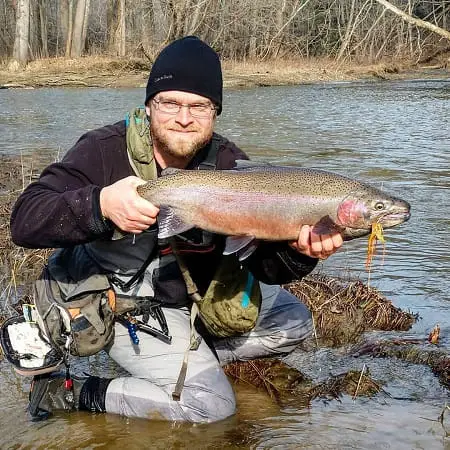
Lake Erie tributaries in Ohio offer steelhead anglers nothing short of abundant opportunities for steelhead fishing.
Ohio has great rivers, streams, and creeks of all sizes that offer high-quality lake-run steelhead, beginning from November to April.
Even though the majority of the steelhead are a result of the stockings by the Ohio Department of Natural Resources, these rivers and creeks also enjoy some natural reproduction of steelhead.
The primary Lake Erie steelhead streams in Ohio are:
- Conneaut Creek
- Grand River
- Rocky River
- Vermilion River
- Chagrin River
- Arcola
- Ashtabula River
Several other Ohio streams that still get a decent run of steelhead include Beaver Creek, Black River, Cowles Creek, Cold Creek, Cuyahoga River, French Creek, Euclid Creek, Wheeler Creek, Turkey Creek, and Huron River.
For more detailed information about each of the listed rivers above, such as their stream access, stream flow charts, and steelhead fishing reports, you can check out my article Best Ohio Steelhead Rivers.
Steelhead Alley in Pennsylvania
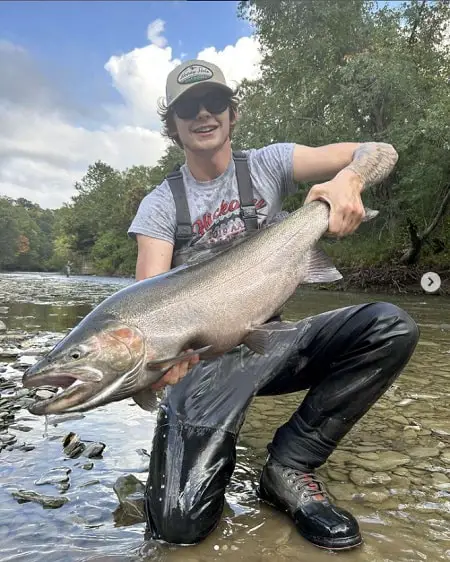
Pennsylvania’s portion of Steelhead Alley has some of the best steelhead fishing opportunities any angler can ever wish for.
Thousands of anglers come from far and wide just to descend on this region of Lake Erie tributaries during the annual steelhead spawning runs.
The reason for the popularity is that there are many nice rivers, all within minutes that are heavily stocked, which can provide fantastic fishing with days of over 50 steelhead landed.
The primary Lake Erie steelhead streams in Pennsylvania are:
- Elk Creek
- Sixteen mile Creek
- Twentymile Creek
- Walnut Creek
- Crooked Creek
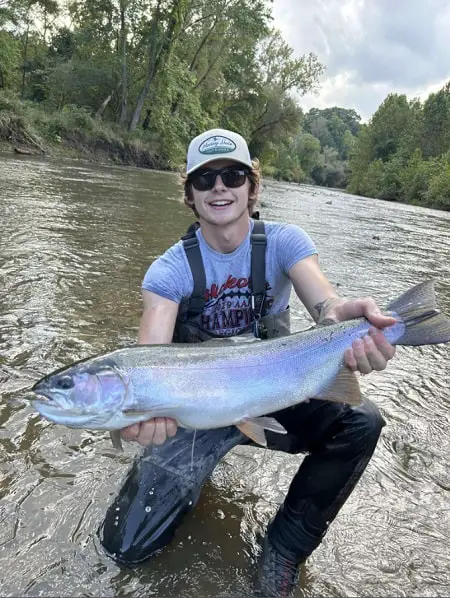
Several other rivers that still get a decent run of steelhead include Upper Conneaut Creek, Raccoon Creek, Turkey Creek, Fourmile Creek, Sevenmile Creek, and Twelvemile Creek.
For more information about each of the listed rivers above, such as their stream access, stream flow charts, and steelhead fishing reports, you can check out my article: Pennsylvania Steelhead Rivers.
Steelhead Alley in New York
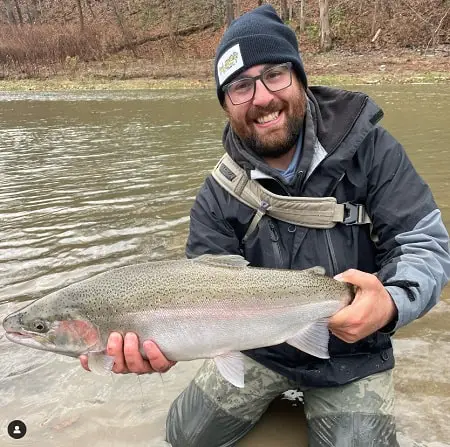
Starting from October through April, New York’s Steelhead Alley receives an annual run of steelhead in the tens of thousands.
This presents anglers with excellent steelhead fishing opportunities on smaller creeks or larger rivers.
The excellent steelhead fishing in this part of Steelhead Alley is thanks to the natural reproduction, stray steelhead that comes from Pennsylvania and Ohio, and from extensive stocking programs.
The primary Lake Erie steelhead streams in New York are:
- Cattaraugus Creek
- Canadaway Creek
- Chautauqua Creek
- Eighteen-Mile Creek
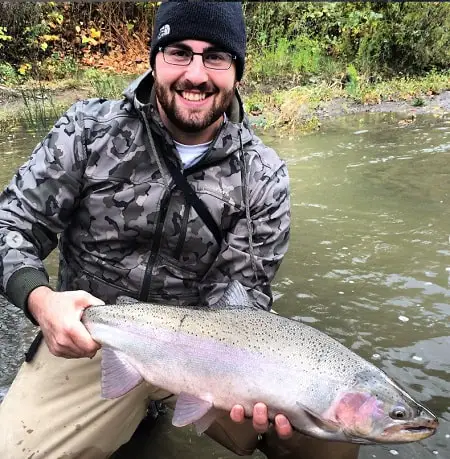
Several other rivers that still get a decent run of steelhead include Little Sister Creek, Muddy Creek, Silver Creek, Twenty-Mile Creek, Walnut Creek, Beaver Creek, Big Sister Creek, Buffalo Creek, Cayuga Creek, Delaware Creek, and Cazenovia Creek.
For more information about each of the listed rivers above, such as their stream access, stream flow charts, and steelhead fishing reports, you can check out my article New York Steelhead Rivers.
When Is Steelhead Fishing Good?
It is only natural that fishing steelhead alley begins when the steelhead start their migration into the tributaries in the fall.
The schedule for fishing between these three home states of the steelhead alley and their tributaries is somewhat similar. What is applicable to Ohio Lake Erie tributaries can also be applied to Pennsylvania and also New York tributaries.
Knowing when these steelheads enter the rivers in large numbers and where they hold and rest determines success.
This steelhead activity is largely affected by water temperatures and major rain events and that means that steelhead can be captured in their spawning runs basically between September and May. There are peak times, which will be discussed below.
Steelhead Alley Fall Season
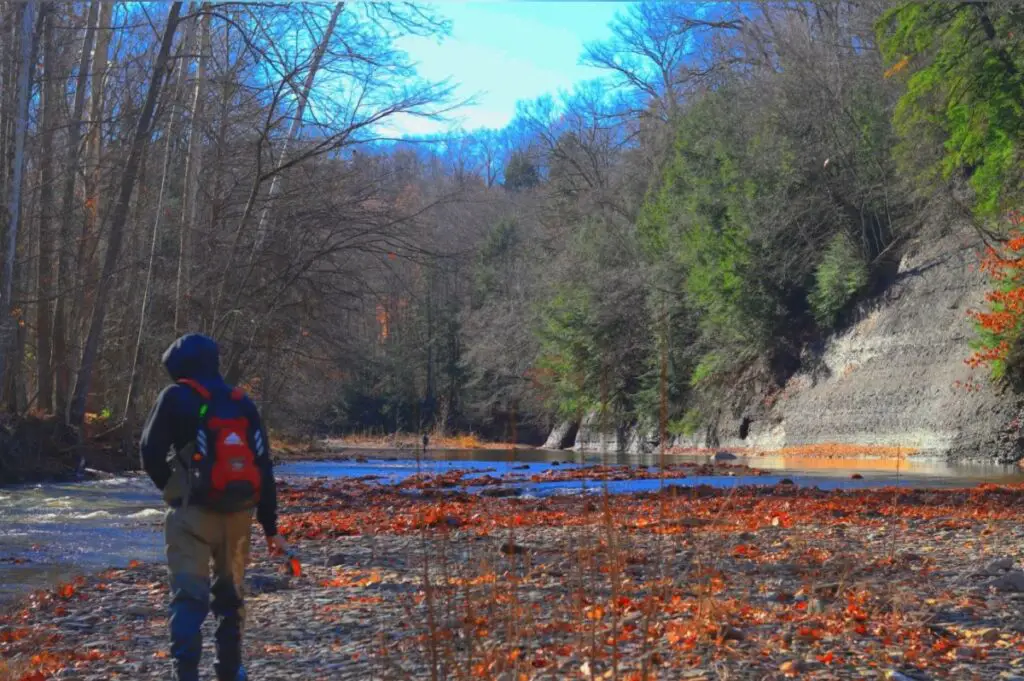
Late August to early September, steelhead stage and congregate along the Lake Erie shoreline when its temperatures dip to about 68 F. For Lake Erie Surface Temperature Map, see here.
During this early fall period, anglers can target steelhead along the shoreline and at the mouths of tributary streams with some success and some anglers may find small pods of steelhead that will move into the river mouths at dawn or dusk and then move out again during high sun.
Colder nights and cold rains, especially heavy rains in September that cause tributary run-off can start to trigger small runs of steelhead into some rivers of Steelhead Alley. Large numbers of steelhead begin running into the tributaries after cold rains in October.
These colder river temperatures help to maintain the metabolism of fall steelhead, and thus, these steelhead will hold in faster water such as the heads, tail-outs, pools, chutes, and fast runs like fast pocket water.
During this time, steelhead in the river are usually aggressive and will feed on well-presented flies, and they will actively chase any available food sources such as minnows, spawn sacs, a dead-drifted egg pattern, a streamer, a nymph, or even a swung wooly bugger fly.
Many anglers make the mistake of fishing the same spots all fall, but as a river guide who spends 30 days a month on the river guiding for steelhead between September and January, I know this is often a big mistake.
Towards the end of fall, which is late November and through December, is when stream temperatures begin to cool between 38-45 degrees. This is when steelhead no longer hold in very fast water. At this time, they will often be found in the midsections of deeper pools, slower pocket water flows, and moderate runs.
I also change my presentations as well as bait and lure sizes, bait colors, and types of baits and lures as the fall season progresses, you should too.
If you want to know more about effective steelhead fishing in the fall, you can look at my page, Fall Steelhead Fishing: Proven Guide Tips And Tactics.
Steelhead Alley Winter Season
Between the months of December and February, temperatures fall down to 32-37F which is when steelhead become more lethargic. Steelhead are generally cold-blooded, which means their metabolism will decrease with falling water temperatures, and thus they lose their ability to hold in faster currents, and they can become inactive.
As a result of the winter icy water conditions, steelhead will be found resting in areas along slow-moving pools, shale ledges in deeper runs, pool back-eddies, slower runs, and the upper pool tail-out of very slow current deep pools. During this time, they rarely move around even for bait, but with the right knowledge, steelhead fishing can be fantastic.
Even when they come across a well-presented bait and do bite, anglers can hardly detect the takes, as they are often soft and subtle.
Winter fishing and guiding can be fantastic, but only if you know how to adapt to the conditions, and know when and where to fish. There is a reason why many anglers struggle to catch any steelhead in the winter, but river guides still do very well at this time of year.
I discuss what you need to know about steelhead fishing, which includes my tips on how I stay warm and dry in the ice-cold water and winter weather, all on my page Winter Steelhead Fishing: Tips And Tactics Of Expert Guides.
Steelhead Alley Spring Season
As the winter comes to an end in late February and during early spring in Steelhead Alley stream temperatures gradually and consistently rise into the ideal spawning temperatures of between 40-58 degrees F, during which steelhead will start entering the river under high water and will begin to move onto spawning gravel.
During this time, these pre-pawn steelhead begin to hold in nearby runs pools, bank under-cuts, and pocket water adjacent to spawning beds.
After spawning, the steelhead will remain in the tributary streams until temperatures further rise to the upper 60 degrees F range. At this point, they begin to head back to the Lake Erie shoreline.
I separate the spring runs of steelhead into three stages and fish steelhead differently in each stage. This has led to a lot more steelhead in the net for me and my clients.
For more on spring steelhead and how to fish them, you can check out my article on Spring Steelhead Fishing: Tips And Tactics From The Guides.
Steelhead Temperatures
Bear in mind that on Lake Erie tributaries, stream temperatures are not constant throughout the day. Water temperatures are usually coldest in the morning and at night, which makes steelhead less aggressive and more prone to hold in moderate to slower-flowing waters.
This is especially true in late fall, over the winter, and in early spring.
Temperatures gradually warm into the afternoon, at which time steelhead will move into faster runs and pools and begin to more actively feed.
With all that has been said, fishing for steelhead on Steelhead Alley is best done in the late fall and winter between 11 am and 3 pm. In the case of winter, the warmest temperatures typically exist during mid-day to early afternoon, which is when steelhead will bite consistently.
So, when you are aware of water temperatures and rain, and how they impact steelhead activity and behavior, you are on your way to catching more steelhead, but there are other things to consider, like the best methods and best baits for the area.
Best Baits
Generally, no one steelhead bait can be said to be the best, as there are different factors that determine their viability. Often, the top baits, or should I say the most popular baits are roe bags, worms, beads, and flies.
Over the years. I have used a number of baits and discovered that these baits have greatly increased the amount of fish I catch on Steelhead Alley rivers.
Bear in mind that the use of each of these steelhead baits will vary depending on factors such as the river conditions at particular times of the year (whether fall, winter, or spring) – the flow and clarity of the water, and the activity level of the steelhead.
I have an article where I discuss my best steelhead baits in detail; which ones to use in different rivers, under different river conditions, and on any given day and steelhead season. I also discuss the best colors and sizes of steelhead baits to use in order to catch more steelhead.
Best Methods For Fishing Steelhead Alley
Again, the methods for fishing between the various Lake Erie and other Great Lakes tributaries are somewhat similar. The methods applicable to Ohio can also be applied to Pennsylvania as well as New York.
I have fished all of the rivers and creeks around the Steelhead Alley and have tried several methods that work very well. It is my opinion that no one method is best for all tributaries.
I discuss some effective methods on my page, Best Way To Catch Steelhead In Rivers.
Float Fishing
Float fishing may be perfect for large rivers with longer, deeper pools but may not be effective in fishing small or medium-sized shallow rivers and creeks.
What works for one river or at one time may not necessarily work for another under different conditions.
Fly Fishing
Fly fishing in Steelhead Alley is very common, and most river guides in the area myself included, prefer this method for fishing steelhead in Steelhead Alley. The use of indicators to present nymphs and egg patterns is the normal way to fish, but there are other good methods that work, and some might work even better.
I discuss all the best methods on my page, Fly Fishing For Steelhead: Great Lakes Style.
Spin Fishing
Spin fishing uses a method known as float fishing, or bottom bouncing is popular and effective when fishing steelhead alley rivers.
Spin fishing with lures is also very effective and a lot of fun.
I discuss in more detail all the best methods for catching great lakes steelhead on my page Steelhead Fishing – Most Effective Methods For Steelhead
Tight Lines
Graham

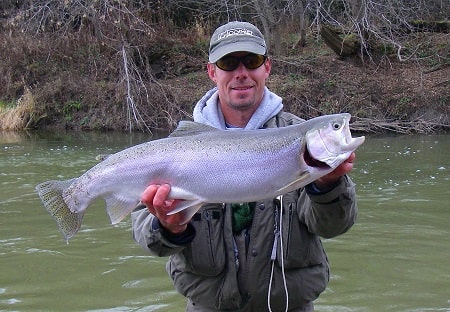
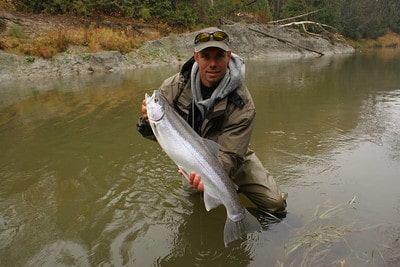
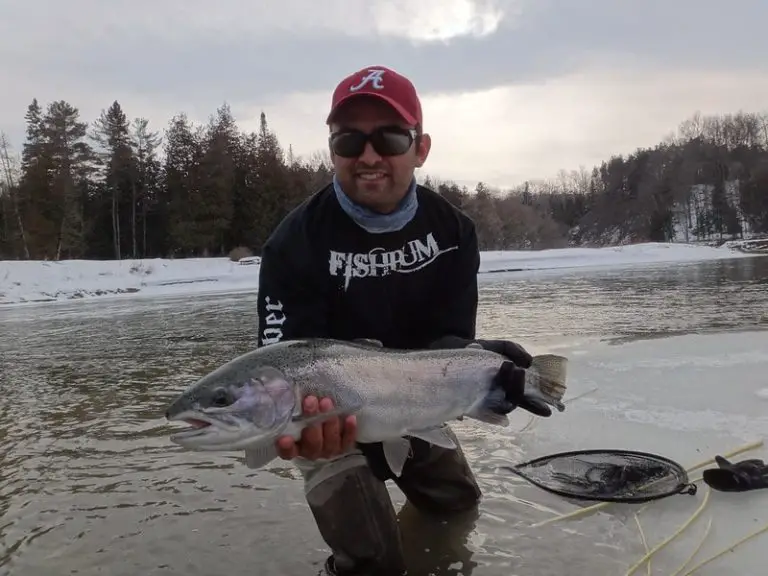
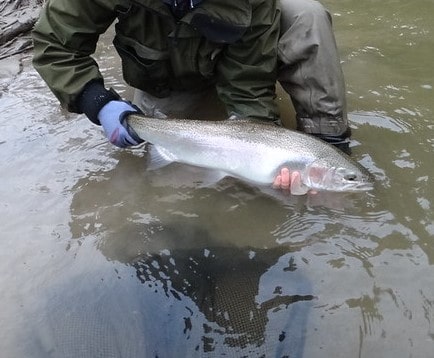
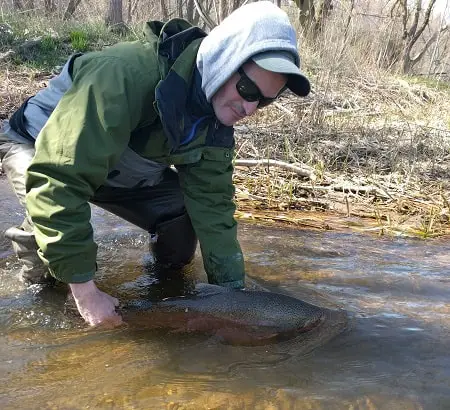
Hello
Are any of the steelhead ally streams and rivers accessible by power boat ?
As I have young sons that would be unable to wade.
Kind regards
Rich
Hi Richard,
Many of the Alley tribs are small and can be fished from the bank and it’s not required to get in the river. I’ve had my 2 daughter fishing the smaller tribs since they were 7 or 8.
if you must be in a boat, you could try the lower Cattaraugus creek in eastern NY, or try to fish up into the river mouths of some of the larger tribs like the Grand river in Ohio. Otherwise, you could try fishing the lake just out from the river mouths.
Best of luck,
Graham